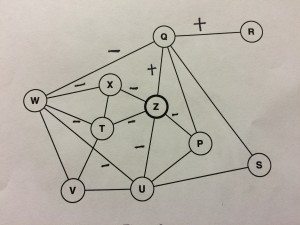Facebook’s Friends Recommendation
The Washington Post addresses a topic that many people have probably asked themselves. How does Facebook recommend you friends? Network science! In simple terms, a network is a graph composed of nodes and edges. In Facebook’s case, the nodes are people, and the edges relationships. Depending on the information that Facebook receives, it sends you recommendations of people you may want to add. But how does it do this? By allowing Facebook to know personal details such as your email and/or phone contacts, location, high school, college, and work among others, you enable them to pair you with the people that match these criteria. With all this information, your social graph just keeps expanding, making it possible for more friendships to form.
We can see a simple example of this by imagining a triangle ABC. Suppose B has a relationship with both A and C. Given that this is true, then there is a likely chance that A and C will develop a relationship due to their mutual friendship with B. This is called triadic closure because A and C’s relationship will complete the triangle. Because of this, Facebook will recommend A to add C and vice versa. However, actual social graphs are much bigger and have way more neighborhood overlaps or mutual friends than a simple triangle. This poses a challenge for Facebook. Does the number of mutual friends top the strength of the relationships? This is where tie strengths and the strong triadic closure property (STCP) come in. The property states that “if a node has strong ties to 2 neighbors, then these neighbors must have at least a weak tie between them” (Easley and Kleinberg 48). When we talk about strong and weak ties, we are referring to the positive (strong) or negative (weak) relationship between the nodes.
For example, take node Z in the figure above. Based on mutual friendships, Facebook is likely to recommend W to Z since they have 4 mutual friends in common (Q, X, T, U). But, if we take into account tie strength and the strong triadic closure property we can see that recommending R is a better option even though it shares only 1 mutual friend with Z (Q). This is due to the fact that Z’s relationship with Q and Q’s relationship with R are both strong and by the STCP, we can conclude that there will exist at least a weak tie between Z and R. On the other hand, the mutual relationships between W and Z are mostly weak and therefore do not guarantee a tie between the two even though they have many mutual friends in common. Thus, when Facebook finally discovers a way to know how you met your friends and the strength of the relationship you share, imagine how much more accurate its friends recommendations will be! Great, scary or both?
Sources:
Easley, David, and Jon Kleinberg. Networks, Crowds, and Markets Reasoning about a Highly Connected World. New York: Cambridge UP, 2010. Print.

